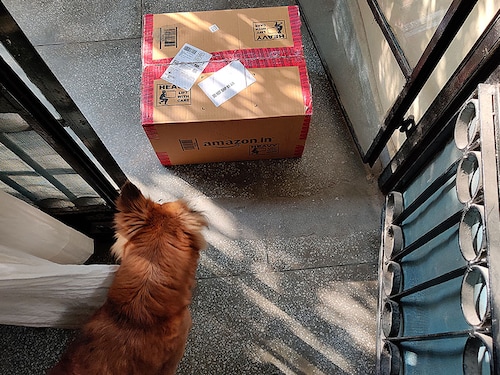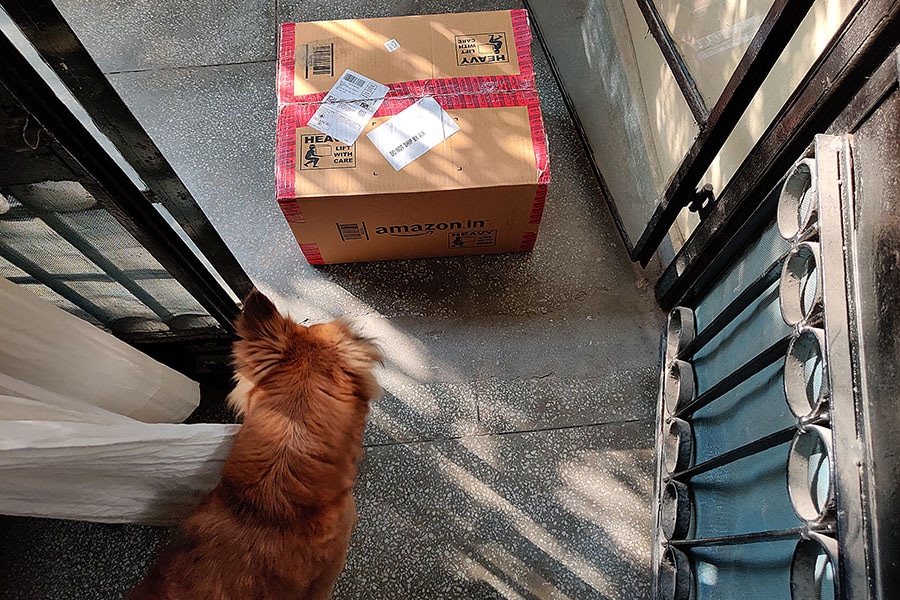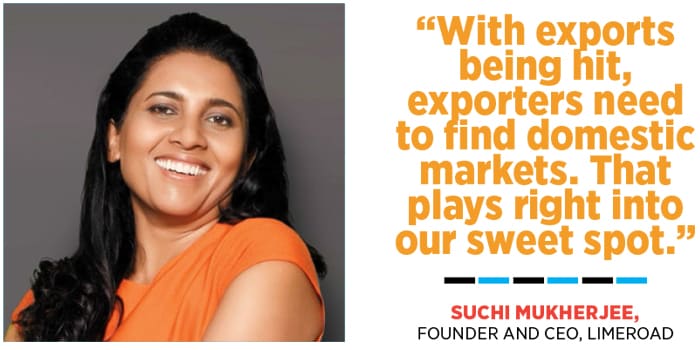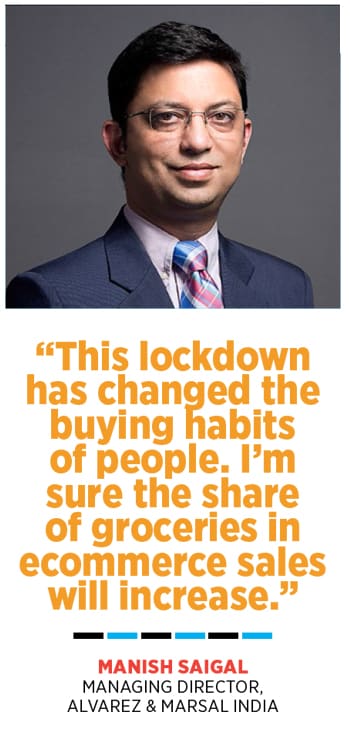Place order, proceed to checkout
In the new normal, ecommerce is set to leapfrog its sales numbers on the back of groceries and social distancing


 The pandemic is forcing customers to change consumption habits, leading to a surge in online orders
The pandemic is forcing customers to change consumption habits, leading to a surge in online orders
Image: Madhu Kapparath[br]Every time Albinder Dhindsa returned home after his meetings with government officials and the police last month, the CEO and co-founder of online grocery service Grofers self-isolated himself in his room for 14 days. Even as he ensured the safety of his parents, minimising contact with them and ensuring they didn’t go out, he kept getting calls from family and friends, asking if he could arrange for essentials to be delivered to their parents. The orders on his website, meanwhile, went through the roof.
“A lot of people have now seen the severity of the lockdown and the general consciousness of how seriously they need to take it has gone up,” says Dhindsa whose platform saw orders going up from 1 lakh a day pre-Covid to 1.9 lakh daily towards the end of April the number is projected to increase by 50 percent this month.
Grofers also saw its average order value go up by 48 percent from ₹1,450 in the pre-Covid period to ₹2,160 by April-end. Similarly, Amazon added over 60 cities that get essential products through Amazon Pantry, its online grocery shopping store, taking the total number of cities to over 85. “Customer demand in all these cities is more than 2x pre-lockdown. Certain categories like staples and packaged foods continue to see more than 2.5x increase in orders over an average day pre-lockdown,” says an Amazon India spokesperson.
As the country readies for life after lockdown, online searches are moving from basics to other home essentials. And ecommerce companies are gearing up to deal with the expected surge in demand.
*****
Demand is expected to shoot up as people adjust to the ‘new normal’ of social distancing, avoiding crowds, working and studying from home, and making contactless purchases and payments. “In the next three months, ecommerce will see a much greater surge in demand than regular offline. It will be 2x of what it is normally, because there will be a lot of non-essentials that people need, like laptops, mobiles and electronics,” says Srinivas Mothey, senior vice president of Paytm Mall. Searches on their website in the second phase of lockdown, he says, moved towards home essentials, electronics and personal care products.
Online retailer Amazon India has also witnessed a spike in searches for items such as books, toys, gaming consoles and fitness-related products as people try to keep themselves engaged, and air conditioners and coolers.
Online apparel stores like Limeroad expect massive demand for essentials within lifestyle, and are activating supply networks around these. According to the company, these will include focus on innerwear, loungewear, basics and athleisure versus formalwear and eveningwear. *****
*****
As the pandemic forces consumers to adopt new habits, re-evaluate priorities and shift consumption, two trends are expected to emerge. One, more and more brick-and-mortar stores will move towards having an online presence to make up for loss of business from footfalls. Two, a behavioural change towards the buying of groceries and essentials online, including tie-ups with local kirana stores, leading to an acceleration in the growth of ecommerce.
Companies like Zomato and Flipkart have already been enabling online delivery for grocery stores using their resources on ground. While such tie-ups have been on the radar of every delivery and ecommerce firm for quite some time, the process has only accelerated in recent times. “The new normal is that your local kirana/departmental store is also available to order on the Zomato app. The pandemic has literally forced us to innovate solutions today, which may have arrived a year or two from now,” says Mohit Sardana, COO, food delivery, Zomato.
The share of grocery in online in India has been relatively small with the majority of ecommerce sale coming from fashion and electronics, in value and volume terms. “But this lockdown has changed the buying habits of people, especially in favour of buying essentials online. So I’m positive the share of grocery in ecommerce sales will increase,” says Manish Saigal, managing director, Alvarez & Marsal India, a business management consulting firm. He adds the sale of groceries or essentials will leapfrog by one to one-and-a-half years.
Just like food deliveries, Mothey also sees things becoming hyper-local on other fronts. The warehouse model, he says, with a warehouse in one city and delivery to another city, will start disintegrating into more of a pin code-level, hyper-local setup for regular essentials and non-essentials.
More and more offline retailers and brands will also be looking at online not just to find ways to liquidate their current stocks and raise cash, but also on a longer term basis, for discovery by users as well as establishing store-in-stores where fulfilment is done by e-retailers.
The offline-online and online to offline integration will possibly start showing results only next year, “but the digitalisation would have happened this year and the number of shoppers will also go up”, says Mothey.
Besides local markets and local offline brands, as well as niche private labels, Suchi Mukherjee, founder and CEO of Limeroad, also sees opportunity on the exports front. The $200 billion domestic apparel market in India breaks down roughly into $130 billion of exports and $70 billion in domestic sales. “With exports being hit, these exporters will need to find markets domestically, and that again plays right into our sweet spot,” she says.
Discretionary spend is also expected to move online, adding to the ecommerce kitty. While earlier a person would simply walk into a mall and end up buying on impulse, that will change. “Discretionary or unplanned stuff will move online as the customer will go out only if it’s absolutely essential,” says Saigal.
Groceries are expected to push numbers in the short term and ‘non-essentials’ will add up in the near future. According to Saigal, online sales in India were anticipated to grow at about 30 percent this year before the lockdown happened.
“In my view, this may just go up to 35 percent to maybe slightly higher. Because the whole push for essential delivery through online has got significantly accelerated,” he adds. The numbers that would have been achieved in CY21 will now probably be achieved in CY20 on a run rate basis. “The run rate of monthly numbers you will see in November, December, maybe the last quarter, might be significantly higher and more in line with CY21 numbers,” he says.
*****The sector is not without its pain points. Disruption in manufacturing and supply chains due to the lockdown means ecommerce players will have to deal with pent-up fixed costs, and higher delivery and manpower expenses. According to a KPMG report in April titled ‘Potential Impact of Covid-19 on the Indian Economy’, the ecommerce sector may see a dip in growth due to increased pressure on supply chain for deliveries. “There might be supply side constraints in terms of availability of stocks, turnaround time and higher cost of deliveries that may constraint the demand growth,” concurs Saigal.
Another challenge for ecommerce companies is that they will need to equip their employees with the appropriate resources to manage operations remotely with little or no disruption.
Perhaps the biggest challenge post the lockdown will be the dynamic delivery situation where containment zones emerge on a daily basis. “For the first month or maybe even two months, there will be just the sheer operating costs of figuring out on a daily basis whether a seller from a particular pin code can ship out today,” says Mukherjee. It could happen that a seller’s area becomes a hotspot and goes into containment, which means the orders the firms had received for them would have to be cancelled and used elsewhere. “So there is that uncertainty, and the same problem will happen on the consumer side. The packet is coming to you, but somebody in your community gets it, your community goes into lockdown or containment. How do we get the package to you? There is going to be that operational challenge and that will have a cost in the system,” she says.
Scarce workforce will mean manpower costs, too, might be higher. “What you"re seeing in China, and I think it’s already happening in India as well, is that deliveries require manpower, trucks require drivers. I think workforce would be scarce because a lot of people who have gone back to their villages will not come back. And those who do will be in high demand,” says Saigal.
However, overall, there is a huge potential for ecommerce, says Harsha Razdan, partner and head, consumer markets and internet business, KPMG in India, “as we expect larger number of consumers to move towards direct supplies to home”.
Mukherjee, too, is confident. “Our view is that post-Covid, the world will really divide up into winners and losers. And that has already started happening in some of the video conferencing pieces. Zoom became the first B2B company to have seen a spike since the outbreak of Covid-19. And online commerce is in the top five winners list that I’ve seen in every single list I’ve seen globally, sitting right there alongside video streaming and video conferencing. That is going to be a reality.”
First Published: May 13, 2020, 12:00
Subscribe Now